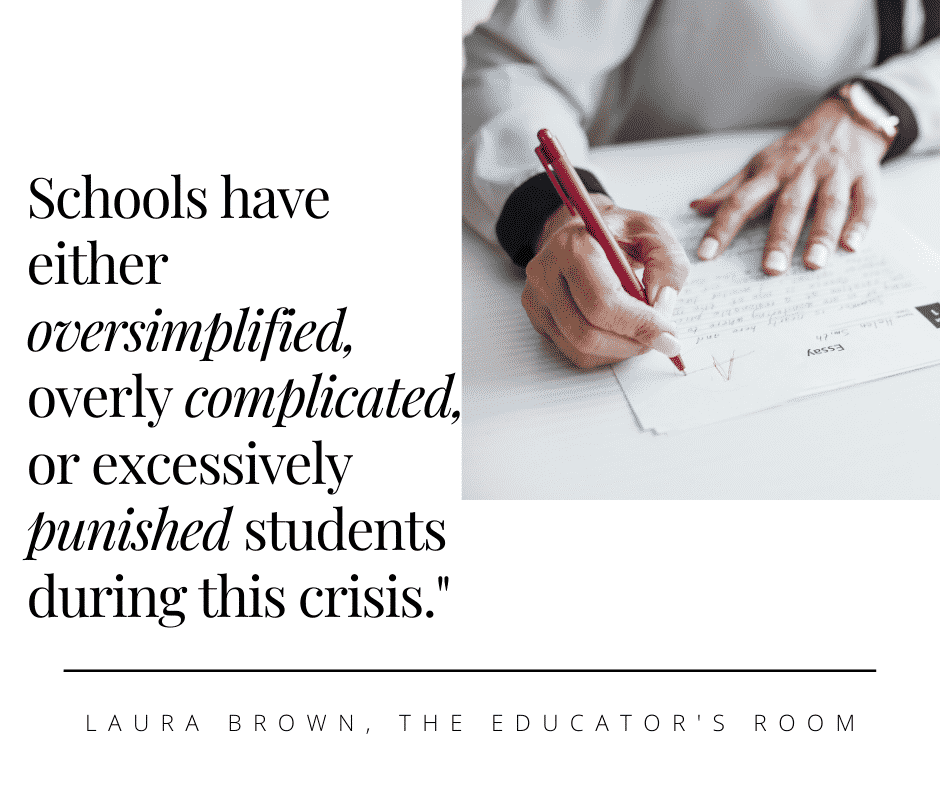Teachers on social media are posting inspirational videos. School districts are compassionately giving students food, paper packets, Chrome Books, internet connectivity, and yard signs for seniors. Educators are doing the best they can to make a monumental shift–that may become the norm for the 2020-2021 school year. There is a critical component of school that is missing, however, and that is the agreement on assessment. Districts have little consistency between neighboring districts or counties for that matter. A Goldilocks phenomenon has emerged. Schools have either oversimplified, overly complicated, or excessively punished students during this crisis. A moderate, or “just right” approach is urgently needed, especially when it comes to autumn plans.
[bctt tweet=”Schools have either oversimplified, overly complicated, or excessively punished students during this crisis.” username=””]
On May 4, 2020, I read an email from my youngest daughter’s school superintendent that included a complicated matrix for third-quarter grades. This plan included adding 5 points to averages based on pre-closing levels. The matrix, overly complicated, seems to echo the message that “everything is made up, and the grades don’t really matter,” very well. Not to mention the third quarter ended on April 3, 2020, and the students are learning of a plan a month later; the method is overly complicated. I am sure the committee that came up with the measures was applying a sense of compassion, but it is misguided. Goldilocks would say this plan is “too hot.”
Other neighboring districts are giving students pass/fail options. This model gives up on assessment and passes students on. While many would argue that it is the only “fair” measure currently, others might say that this system offers no incentive to learn or engage in the curriculum. For schools in New York, we have two months remaining. Two more months of work to earn a pass or a fail? And, what about grade point averages and transcripts? Will COVID-19 be stamped on everyone’s high school transcripts? Goldilocks would declare that this plan is “too cold.”
A few schools are punishing the students with a school-like scheduled day and forcing pupils to attend live sessions and hand in assignments punctually. These schools tend to be private and expensive, so maybe the parents expect to pay for high standards. Public schools must educate everyone as equitably as possible, accomodating poverty and domestic issues. Goldilocks cannot afford private school porridge.
There exists, however, a “just right” happy medium approach to assessment. The path ahead is forged by teachers, who professionally and empathetically engage their students with meaningful content (as much as possible). These teachers are encouraged by school leaders to design their lessons and assess their students with flexibility but without abandoning a sense of accountability. This system, thankfully, is how the district for which I am employed is supporting. It is not perfect; nothing is perfect right now. It is, however, familiar. The traditional approach does not make students and parents shake their heads at complicated matrixes based on figures a month past. Nor does the gentle, but “regular” approach to assessment lose the engagement of high achieving students.
Within a 50-mile radius of my home in Central New York, various school district superintendents are taking distinct paths when assigning grades during a crisis. These divergent paths have implications, especially for high school students. Furthermore, the approaches demonstrate the inequalities in the ways schools value education. Leadership, coordination, and stakeholder input is desperately lacking during this time. A recent, satirical New York Times article summed up the dilemma well:
“Having no plan is the plan! Haven’t you been listening? Plans are for commies and the Danish. Here we do it fast and loose and dumb and wrong, and occasionally we have a man who manufactures pillows come to the White House to show the president encouraging texts. It all works! Eighteen months, 800,000 deaths, no plan, states bidding against states for medicine and equipment, you’re on your own, plans are lame.”
Teaching and leading schools during a crisis is incredibly fatiguing. The decisions made seem monumental. Leadership and consistent plans are desperately needed. If local, neighboring school districts cannot coordinate, what is the hope that government agencies will function properly? Schools are always mirrors of society, why should this time be any different?






